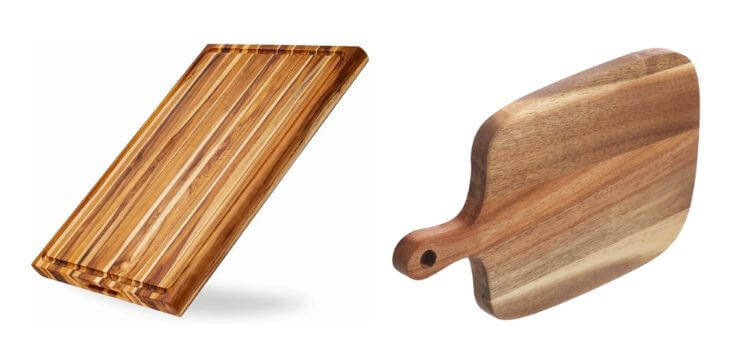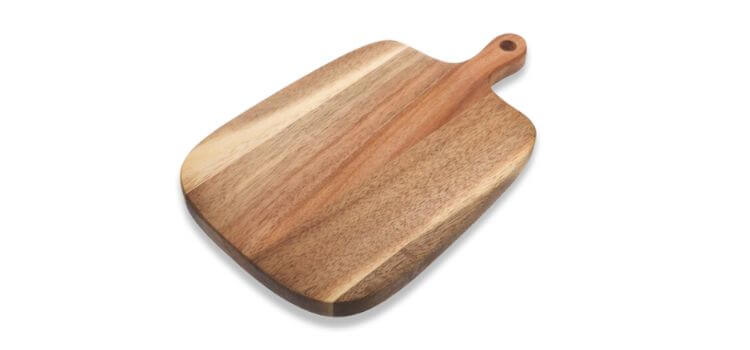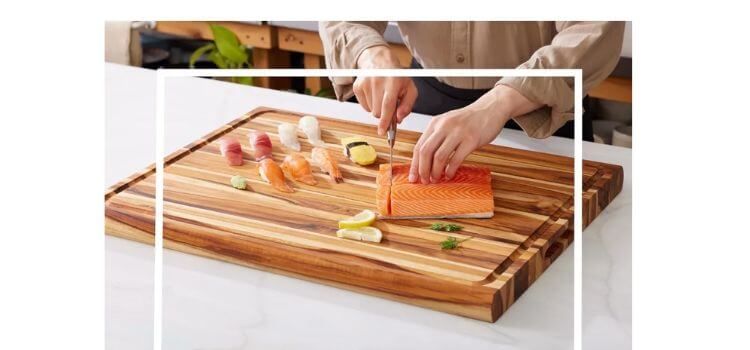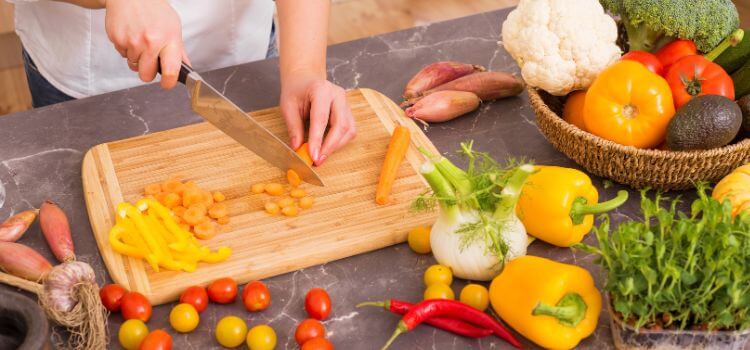As an Amazon Associate, I earn from qualifying purchases

When selecting the ideal cutting board for your kitchen, the choice between acacia and teak wood can significantly affect both functionality and aesthetics. This article examines the unique attributes of acacia and teak cutting boards, focusing on their durability, maintenance needs, and overall performance.
Our goal is to provide you with the insights needed to make a well-informed choice for your kitchen. Dive into this comparison to discover which wood type aligns best with your cooking needs and style preferences.
Acacia Cutting Boards

Acacia wood, a durable hardwood, originates from the acacia tree, indigenous to Australia and Africa. It’s known for its durability and resistance to water damage, making it ideal for kitchen use. Acacia cutting boards are also renowned for their natural beauty, with distinct grain patterns ranging from light brown to dark golden hues.
Pros and cons of using acacia cutting boards
Pros:
- Hardness: Acacia wood is known to be one of the hardest and most durable wood types, making it resistant to scratches and cuts.
- Water resistance: The natural oils in acacia wood make it highly water-resistant, preventing warping or splitting when exposed to moisture.
- Aesthetics: With its unique grain patterns and varying colour tones, acacia wood is a visually appealing and stylish option for cutting boards.
Cons:
- Maintenance: While acacia has natural antibacterial properties, it still requires proper maintenance to prevent bacteria growth and maintain its durability.
- Knife dulling: Due to its hardness, acacia wood may cause knives to dull faster than other cutting board materials.
Maintenance for acacia cutting boards
To maintain the quality and lifespan of your acacia cutting board, you should follow these maintenance tips:
- Hand wash with warm, soapy water after each use.
- Dry thoroughly before storing to prevent moisture-related issues.
- Oil periodically with food-grade mineral oil replenishes natural oils and preserves their water resistance properties.
Teak Cutting Boards

Teak is a tropical hardwood commonly found in Southeast Asia and is known for its strength, durability, and natural resistance to moisture. Its distinctive golden brown color and smooth grain patterns make it a popular choice for cutting boards.
Pros and cons of using teak cutting boards
Pros:
- Durability: Teak wood is highly resistant to wear, making it a long-lasting option for cutting boards.
- Moisture resistance: The natural oils and rubber content in teak wood make it resistant to water, preventing damage and warping.
- Low maintenance: Teak cutting boards require minimal upkeep due to their natural antibacterial properties.
Cons:
- Price point: Teak wood tends to be more expensive than other types of hardwood, making it a pricier option for cutting boards.
- Color changes: Over time, the golden brown colour of teak may fade to a silver-grey if not regularly oiled.
Maintenance for teak cutting boards
To maintain your teak cutting board’s quality and appearance, follow these maintenance tips:
- Wash with warm, soapy water after each use.
- Dry thoroughly before storing to prevent water damage.
- Oil periodically with food-grade mineral oil to maintain natural moisture resistance and colour.
A Comparison: Acacia vs Teak Cutting Board

- Durability: Both acacia and teak wood are renowned for their durability, making them long-lasting options for cutting boards. However, acacia’s hardness may make it more resistant to scratches and cuts than teak.
- Maintenance: Both acacia and teak cutting boards require periodic oiling to maintain their natural moisture resistance properties. However, due to acacia’s hardness, it may be more prone to knife dulling, requiring more frequent oiling.
- Aesthetics: Both acacia and teak wood have unique grain patterns and colour tones, making them visually appealing cutting board options. Ultimately, selecting one over the other boils down to individual taste.
- Hygienic: Both acacia and teak have natural antibacterial properties, making them hygienic options for cutting boards. However, proper maintenance is still necessary to prevent bacteria growth.
Choosing the Right Cutting Board
Factors to consider when selecting between acacia and teak cutting boards:
- Usage: If you require a cutting board for heavy usage, acacia wood’s hardness may make it a more practical option. However, acacia and teak are suitable choices for light to moderate usage.
- Budget: Teak wood tends to be more expensive than acacia, so if budget is a significant consideration, acacia may be the better option.
- Style preference: Acacia and teak have different grain patterns and colour tones, allowing you to choose the one that best suits your style and kitchen aesthetic.
Recommendations based on specific needs and preferences:
- Heavy usage and durability: Acacia cutting board.
- Low maintenance and natural water resistance: Teak cutting board.
- Budget-friendly option: Acacia cutting board.
- Stylish and visually appealing: Both acacia and teak cutting boards are suitable options, depending on personal preferences.
Conclusion
Both acacia and teak are excellent choices for cutting boards, with their unique features and natural beauty. When choosing between the two, consider your needs and style preferences to make the best decision. Remember to maintain your chosen cutting board properly to ensure its longevity and hygienic properties.
Regardless of your choice, acacia and teak both offer durable and elegant options for enhancing your kitchen. So, it is important to weigh each type’s pros and cons carefully before deciding. Happy chopping!
As an Amazon Associate, I earn from qualifying purchases